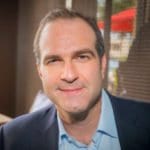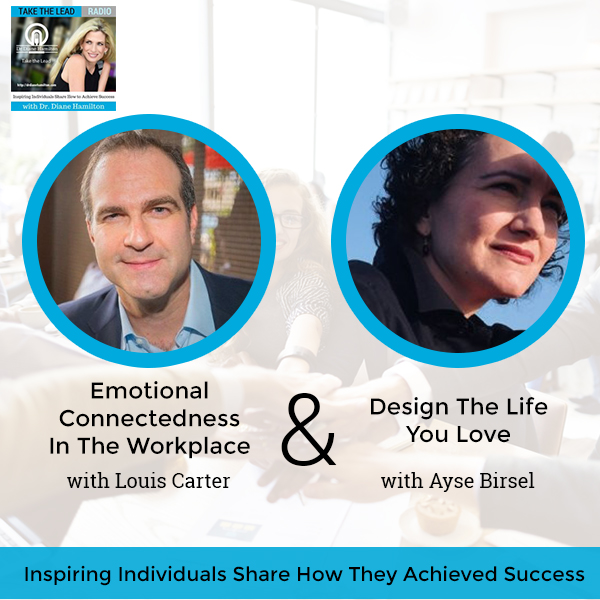
We have Louis Carter and Ayse Birsel. Louis is the CEO and Founder of Best Practice Institute. He’s the author of In Great Company and he’s a member of the Marshall Goldsmith MG100. Ayse Birsel is named one of Fast Company’s Most Creative People of 2017. She’s the author of Design the Life You Love. She’s got a great TEDx Talk and both of them are fascinating.
Listen to the podcast here
Emotional Connectedness In The Workplace with Louis Carter
I am here with Louis Carter, who is the author of more than ten books on best practices and leadership and management, including a book called In Great Company: How To Spark Peak Performance By Creating An Emotionally Connected Workplace. You’ve spoken to some pretty amazing places. You spoke for a Prime Minister and The Pentagon. You’re a drummer, is that true?
I am. I have drums in my office. I love drumming. I’ve been doing it for 35 years.
My dad was a drummer and they had some old albums that he was on. You’re very talented. You’ve done some amazing work with your other books. Everybody knows your name. Your new book is interesting to me because you’re talking about emotional connectedness. I wrote my dissertation on emotional intelligence. Emotions are so much a big part in terms of success. What led to your interest in wanting to write this latest book?
I became interested in emotional connectedness because of the work I’ve been doing with the Best Practice Institute Senior Executive Board. We’re creating communities with the Board, within the organizations and with them as a whole. I said to myself, “What brought everybody together? What keeps people together? What keeps them sticky? What keeps that fabric together?” I began to look at the different ways, methods and reasons why people come together.
Do you want to share any of those?
There’s a myriad of reasons why people come together and why they’ve described why they want to stay together and perform even more. It all comes down to one common denominator. We call it respect, which is what we call now as social currency. It’s deeper than that. It gets into a concept that Amy Edmondson speaks about in her work called psychological safety. Psychological safety means you feel free to express yourself, your thoughts, even your emotions inside of a team or group in a way that you will not feel like or you will not be shamed or feel guilt for. Shame and guilt are different from expressing yourself. When people have that feeling inside of groups, it’s explicit rather than tacit, which is typically what happens in psychological safety. People think it has to be there or it isn’t there, it’s tacit. In reality, it’s not expressed or brought on the table. When they do that, there are fewer mistakes, there’s higher performance and the group begins to stick together a lot longer.
My book is on curiosity. I created an assessment to go along with it that measures the things that keep people from being curious, and fear was a huge factor. I had fear, assumptions, technology and environment. When you have this fear that you’re going to be berated or made fun of, people don’t participate. They don’t become curious. They give up. That was one of the most challenging things I found was to measure the things that held people back. You’re dealing with the same things. Part of what I was trying to do was create solutions as well, not just determine the things that hold people back. What can we do next? If leaders are holding people back because they can’t express their opinions or their emotions, what’s the solution? How do we fix that?

Emotional Connectedness: Psychological safety means that you feel free to express yourself or your thoughts, even your emotions, inside of a team or a group.
There are a lot of ways of looking at it. The companies and CEOs that I spoke with in the study all point toward one big thing. It’s not about their amount of bravery inside of a group, their courage or their commitment to pounding their fists on the table, which happens often. They do it for effect. Everybody I talked to had something interesting about them, which is this. They have a veneer. They have a structure in front of them where it protects them from expressing themselves in a way that is safe to themselves and others. Think of it like everybody has this rock outside that says, “I must be a certain way or else,” and culture gets in the way of that. I had a discussion where the organization that I was working with had a definitive cultural norm. It was to be indirect to say, “If you come back to us with this, then we’re not going to be happy,” and it puts saying, “We work weekends. Do you work weekends?” and trying to fit us versus them. They were under immense pressure.
I stopped and said distinctly, and this is something I talk about in my book, “There’s one way that we work and I want to know now if you will agree or disagree with this. If you disagree, it’s completely fine. I’ll respect that.” I’m going to say the statement, “We all agree you will agree to collaborate and co-create with us.” I use those words so that when we present something to you and we’ve worked hard enough, I’m presenting something to you. You can give us feedback, feedforward advice on what you think works for you and what does not work well for you instead of going out, leaving the room and saying, “That didn’t work,” or dismissing it outright and indirectly, which wouldn’t help anyone. What I did was I invited a win-win situation rather than a win-lose situation. It was clear they were going to be ready for a win-lose because of the pressures they were under and wherever it may be that they had thought about. The book is about how you set up the structure and environment for that. If you don’t have it and we’re always in that fight or flight mode, you’re going to see mistakes.
[bctt tweet=”Strive for connection and love for self and others.” username=””]You were talking about things that they dismiss. If there are certain things that are commonly dismissed that people reject because they’re used to a certain culture that intimidates them or whatever it is that they automatically say, “I can’t, I’m worried about that,” you’re able to calm them down with those issues.
There are three things people reject. Number one, they reject things that they do not know or are not familiar to them. These are the elements that they see as inorganic or different from what they are. They’re expected in their environment. They say, “That’s not me. That’s not us. Don’t come in. That’s not right,” and they put a door out and you have to figure out the lock to get in. The truth is that there’s more sameness than there are dissimilarity within us all so we have to get to that with that. Rejection of what is not us. That’s number one. We also look towards things that are stressful to us in our minds or we feel will harm us in some way. Fight or flight is prevalent everywhere. You see it in everything we do. We want to succeed. We want that performance. We want the sales. We want the figures. I want to improve the stock price. The stock market may be plummeting so we want to find ways to immediately correct that situation. There are things that we cannot control. The falsity is that the people that create the most amount of stress are that there are things we can control and things we can’t control.
We have to understand the difference between those and define them in all of our work and what we do. Some things are within our control, some things are without our control. Once we make that, we surrender to the fact that there is a person in control and we have to make peace with it. We stopped that process of pushing that blame away and that there are other forces in control. The second one is about command and control, not being in control of your environment. The third is not knowing yourself properly, the things that you have been. Upper left-hand quadrant is things that I used to be that I want to keep. Bottom left-hand quadrant is things that I used to be that I do not want to keep anymore. On my upper right-hand quadrant are things that I want to be, I will be and that I wish to be but need to do certain activities to get there. On bottom right hand is things I’m going to take with me to become who I want to be. It’s this inner awareness of, “This is who I am. This is what I’m doing. This is why I’m going to do it so that I can internalize it and I can do it on an activity basis.”
Every time I talk to a coaching client and I set up the environment with them, I say, “We’re going to discuss values and goals.” That sounds trite to most people. I mean it though. We’re going to talk about what it is that you want to accomplish at the end of the year not just on a business level, also on a leader level. What is it that you want to accomplish to get better than you already are? That’s the great leader to get an even better leader. Most people who work with me, you see emotional connectedness. They also want to get better and realize what other people perceive so they can build and develop greater relationships. The third is about that perception awareness. Perception awareness is garnering information from your stakeholders. Getting data from them in terms of how they perceive you. What do you do well? What could you do better? One thing you should stop, start or do more or less of and then collecting that info is determining what is the one thing you want to do to change to get to that new place, and then working it with each stakeholder.

Emotional Connectedness: Great leaders want to get better and realize what other people are perceiving so that they can build and develop greater relationships.
Stakeholders talk about myriads of things like agendas and things they say, “That person said this because of that interaction or they did this because of that,” so they blame everybody. One thing they don’t do and it takes a long time to get chipped through this veneer. When I say a long time, it’s three, six, nine, twelve. It’s a year process. They don’t yet see that it’s not about agendas. It’s not about blaming. It’s not about anything to do with anything business-wise at all. It always comes down to the people and the way you feel about how somebody is behaving or reacting. Whether or not you have the instructions in a way that it doesn’t increase anxiety in the way you think. You get the communication in the way you need it. That is it.
There’s a lot of noise that happens during the calls about, “This is wrong or that is wrong. What about this issue and that issue?” All they ever need to do is chisel it down. It all comes down to open, active dialogue and communication always. Not everybody sees it at first and then they start to say, “It really is just that,” and they start changing procedures in emergency rooms, inside of nursing circles and manufacturing environments where huge safety issues occur. They say, “It all came down to being open with communications. I didn’t have to put 6,000 tasks on somebody’s laptop. I had to go down the hall and talk to them.” Do a hybrid of the two. That’s why I’m so mad. It’s because I have these tasks and I can’t go home because I can’t get through them. Look what you’re doing. Let’s go back to Marcus Welby days.
That goes with the Millennials when you mention that. I remember it.
That’s the thing about remembering. Clearly, you and I both have a memory about a time, space and place in our history. It’s more connected and less disconnected from technology, from continuous task orientation and continuous directive approaches that are harmful and unproductive.
You brought up Millennials, I did too. It’s such a conversation in any organization. I’m curious if you see the same control issues in all generations? Is it more in one than another?
[bctt tweet=”Doing things that you know are right and good will feed your soul and feed your mind much greater than anything you’ll ever do in your life.” username=””]There are a lot of different studies out there and you probably know the books around generational differences, generational communication styles and ways to communicate better. I’ve always come down to one thing when it comes to new generations. They’re now becoming the not so new generation. The way I see it is that every new generation is similar to being an entry-level employee. They’re learning new ways of interacting just like we may, placing us whatever our generation may be into an environment. I believe that all of the studies have been done as a way to help people, probably even place us into boxes so that we can understand it better. It’s like, “An alien walked in. Is that alien B? Is that alien C? It’s not. It’s somebody different and new that’s younger than you or older than you. It’s a person.” When we start looking at generations as human beings, we’ll always win. If we delineate by generational definition or nomination, then there’s more than likely a chance that we’ll end up falling short of our communication with that.
A lot of people want to stereotype people as one thing or another. You need to know people on an individual basis. You and I both know who Marcus Welby is, common in our time. You need to know people based on who they are and what they’ve experienced. I’m interested in not just your new book but you’ve written many books. You even wrote one with Marshall Goldsmith. Are you part of the MG100?
Yes.
It’s such a great group and I got to see a few of you guys when you were here in Phoenix. You know what I find different about your group is there’s such a sense that it’s not about the money. It’s about what you are passionate about. I go to a lot of these groups where it’s much more about the money. You guys do well, don’t get me wrong, but you guys seem to have a different culture within that group. Do you find that that’s a different group compared to any of you have been in?
There’s no doubt. We do have a commonality. Our job is to contribute to the greater good, even if we have to pay for it and we do oftentimes. We pay and for a reason. We met at the World Bank with Dr. Jim Kim and we all believe in ending world poverty and alleviating world hunger. We believe in that and we’ll do anything to help them, whether it’s executive coaching or helping in those environments. We have this similarity, commonality about how we work with an organization. My colleagues are kindhearted people and you are too. I’m not saying that you aren’t. You are similar to that as well. We do. I wouldn’t say we’re do-gooders. I would say we’re do-greaters. A do-greater is different because we do want to improve ourselves and we’re not saying financial rewards aren’t what we expect because we do expect to be financially compensated for our work.

Emotional Connectedness: Our job is to contribute to the greater good even if we have to pay for it.
What we do fundamentally all believe is that the stakeholder-centered or transformational approach for getting better is the way. We all believe that there is a common denominator for communication. What I was describing before was the stakeholder-centered coaching method applied to emotional connectedness. We all believe that by gaining the input and direction of others who are close to us, who see and observe our behaviors on a daily basis. Being able to do a cost-benefit analysis of their advice to us as to whether or not it will help or improve us. Practicing on a daily basis those improvements will get us better over time. We subscribe to that methodology and also to pay that forward to the world in whatever way we can.
That’s admirable. You talk about improving and then it brings me back to you when you were talking about the box where you do not want to keep. What part do you not want to keep and change? Is there anything in that corner for your box?
A lot of this stuff I have let go of and finally came to a place in my life where I feel I’m doing the important things that I want in a family. My role in the family is most important to me. I’ve let go of that place with me when I was younger where I didn’t want to have those disconnected relationships. Now, I’m in full relationship in family and life. I dive fully deep end with respect, care and collaboration. That was a huge transformation for me and that’s something I would tell everyone, whether I’m talking to a group of new-minded, fresh, minted graduates who are ready to go take the world by the neck.
It’s time to take a step back. Even now you’re trying to say, “Don’t forget what you’re striving for, what you’re going to do.” What you should strive for is connection and love for self and others. That is to me family and doing things that you know are right and good because it will feed your soul. It will feed your mind much greater than anything you’ll ever do in your life to be high performance or be the best and greatest at what you do or even make the most money. We shouldn’t compare ourselves to others. It doesn’t matter. When you talk in a room and you may flub up, make a mistake or whatever it may be, no one cares. Nobody cares.
[bctt tweet=”We shouldn’t compare ourselves to others. When you talk in a room and make a mistake or whatever it may be, nobody cares.” username=””]Everybody thinks like that. That’s interesting to look at how our perceptions are of what other people are thinking about. Everybody’s thinking the same thing. They’re all thinking about they don’t want to make a mistake. They’re not paying attention to what your mistakes are as much. In your book though, it’s called In Great Company. Do you have company examples in your book? Is it case studies? What exactly is it? Can you give a little more outline of how the book is set up?
The book is set up by case studies and also by area. There are five different areas of the book that have been shown to have the most impact on retention and performance management. Those are collaboration or co-creation, ethical alignment, the practice of respect, treating a positive outlook for the future and having a collective achievement orientation. What we’ve done is we’ve broken up the book into those five parts and shown companies that have outstanding or actual practices in one of those areas as a springboard to becoming fully in great company. We have an emotionally connected index that we developed from the work that determines whether or not a company is in fact in great company or emotionally connected. You can determine if there are areas of deficiency and then go into that area of deficiency and then make it the central focus or at least give good data for it in conjunction with the CEO coach and also top exec coach or top team coaching.
It gives good data and there’s a myriad of great examples. The one that I always love is Patagonia who connects their values strongly with that of their customers and their employees. The CEO is very involved in making sure that the values are that of the organization and the customers and get the sense that, true or not, we don’t believe in conspicuous consumption. We want to make the world a better place and the environment a better place. In fact, that is their customer base. People who are environmentally conscious, they are skiers and outdoor people. They’re in nature, the natural environment and environmentalist. They have to connect to that audience.

Emotional Connectedness: If there are areas of deficiency, then go into that area deficiency and make it the central focus.
As a result, their values are strong. It’s a values-based organization. There are other companies. There are some healthcare clinics as well where their CEOs are committed to doing better and making values the central component of their clinic and saying, “We’re doing great. We’re seeing this way and we’re the best of the best in the area. However, that’s not enough for me. I want to move forward with being the best patient-centered care clinic in the nation.” There are examples like that and you get into the details. There are a lot of different examples in the book of work CERPA, that’s the acronym. We changed that to spark, it was sparking peak performance and you’ll see the iteration of how it works. In the book, you’ll see that the whole point is that you can kick off a program anywhere on those five and then the rest fill in.
You have high values. People come together, they’re more collaborative. Their respect is greater because you’re able to have a touchstone to the values itself. You can look to a positive outlook for the future because you can relate it to other global elements about the environment or the way we work, interact, listen and observe. Your achievement orientation is a lot clearer because things like advertising or branding are a lot easier. What they did was they put this big poster up during Christmas season and said, “Don’t buy our product. This Christmas season, you’ve got to stay home. Don’t buy more jackets or Patagonia products.” You know what happened. People loved it and they bought more Patagonia. They had record sales that season. It’s that thing where everything that is done relates to the work you value.
It comes out at the beginning of 2019, but if people want to find out more about that or you, how can they find out more? Can you share some links?
Go to LouisCarter.com. It’s all there. In Great Company, the book, you can get on our mailing list. You can get even the questionnaire for being In Great Company. You get assessments. You can get a free subscription or registration to our Sparking Peak Performance Tool. You check up on what you’re doing every day. It sends you an email, you go on your app, it’s done. It’s like, “I did that. I did my best today to be positive.”
That’s unique. I haven’t seen anything like that.
It’s called Spapper, Spapper.com.
Congratulations on yet another book that I know will be as successful as the rest. It was nice to have you on the show, Louis. Thank you.
Thanks, Diane. It’s great talking with you. Thanks for having me on. I appreciate it.
Design The Life You Love with Ayse Birsel
I am here with Ayse Birsel, who’s one of the Fast Company’s Most Creative People in 2017. She’s the author of Design the Life You Love, a book and coursework that teaches how to create meaningful life using design process and tools. I was watching her TEDx Talk, If Your Life Is Your Biggest Project, Why Not Design It? Our friend, Claire Diaz Ortiz, introduced us. She had great things to say about all the things you do with creativity, which ties into what I work with curiosity. I found your TEDx Talk interesting because you give a little bit of background what led to that. I was wondering if you wouldn’t mind sharing that story of what led to your interest that you said you had this perfect life but then you got shook up a little bit.
What started this whole thing is I’ve been a designer for many years and that’s where my expertise is. I was lucky because I got to work with some of the best Fortune 500 companies that are design leaders from Herman Miller to Hewlett Packard to Target to Toyota. We had this great studio doing innovative work and I am partners with my husband, Bibi Seck. We were working on these projects together and riding high until in 2008, the economy crashed. Suddenly, all our clients took their work in-house, which was a natural response to the crash on their sides. I hadn’t seen it coming. I found myself with a lot of time in my hands and a lot of frustration and worries. A friend of mine, Leah Kaplan, knows me well and we’ve worked together for many years. We say we’ve worked together since we were kids. She saw it as an opportunity and she told me, “You have all this time in your hands. Why don’t you use this time to think about how you think because you think differently?”
[bctt tweet=”Deconstruction is taking something apart to see what it’s made up of.” username=””]That was a lifeline for me. I thought, “Leah still believes in the how I think and that it has value.” I started mapping out how my intuitive design process. It was an interesting journey into myself figuring that out. After that came Deconstruction:Reconstruction, our design process which we use with all our clients. As soon as I did that, two things happened. One, GE called and they said, “Come and talk to us.” When I showed them Deconstruction:Reconstruction they said, “We want you to deconstruct and reconstruct the value of design for us across five or our businesses.” That was a great turning point back to having a great corporate client and the beginning of our ten-year collaboration with GE. The second thing was I decided to apply Deconstruction:Reconstruction to my life as an experiment and that was the beginning of Design the Life You Love.
This whole Deconstruction:Reconstruction, you’ve got it trademarked. What’s the Deconstruction:Reconstruction process? What are you designing exactly? A lot of people might not be really clear on that part for companies.
Deconstruction:Reconstruction is a four-step design thinking process and it’s rigorous in that it takes you through deconstruction, which is taking something apart to see what it’s made up of. The second step is a point of view. How can we then look at the same things and see them differently? The third step is reconstruction, the other side of deconstruction. Now that we’ve seen things differently, how can we put it back together again to create new value? Knowing we can’t have everything, what are we going to choose in this new combination or new reconstruction? The fourth and last step is giving it a form, expressing it. The expression could be many things. It could be a new business. It could be a new business strategy. It could be a vision. It could be a product, a service or an experience.
To your question about where would you apply this. Frankly, we’ve applied it to many things from design excellence with Harvard Business Review design team to management with the Drucker Management Institute to luxury with Toyota around vehicles. Again with them around adventure and Millennials, around aging. It’s the idea that you can apply to any topic, but then the steps are rigorous. It literally walks you through the process of how can you think creatively but within a certain structure. Within that structure, you can be incredibly creative. That’s the sweet spot is the one between rigor and being creative.
Let’s start with the Harvard Business as an example. What thing did you do for them specifically? You had so many diverse examples. You’re on the Thinkers50 shortlist for talent for a good reason. You do unusual stuff.

Emotional Connectedness: With the rate of change that’s happening in the industries, we need a great framework and structure for thinking with agility.
This is now becoming usual because in a sense, at least for us, many of our clients with the rate of change that’s happening in their industries need great frameworks and structure for thinking with agility. How do you manage change? This is how you manage change. Coming back to, for example, what we did with HBR, we did two sessions with them that had different topics. One was deconstructing and reconstructing their design team to understand what the vision of that team is and what are the roles and goals of that team, putting that on the table and doing it together with them was incredibly helpful. One, it’s to build ownership around the emerging vision, but also for everybody to understand, “If I’m a team player in this team, these are the qualities that I need to embody.”
One of them, for example, was initiative taking. If you were part of that team and you are not a person who was comfortable taking initiatives, it meant two things. One, is this a skill I want to learn? Maybe I don’t feel honest in this team. The second piece of it was the excellence. This was with their design team, the design force behind all their publications. It understood deconstructing and reconstructing excellence so that it could become something that they could repeat again and again. That was a lot of fun because we showed them that they have many instances of excellence. We pulled with their help the examples of excellence that they already accomplished, but then deconstructed those to understand these are the principles and the must-haves of excellence. Once you have that, it becomes a repeatable framework. From that, we were able to drive the rules and plans for excellence.
When you’re deconstructing things, how much are you finding out that there are silos and issues that they had no idea were occurring?
All the time.
[bctt tweet=”It’s not for lack of wanting, but people easily fall back to their old habits.” username=””]Are you aware of that or is it a surprise?
What I find interesting is that a lot of companies are aware of it. While they’re aware of it, they’ll still fall into the silo trap. A simple example for these sorts of collaboration to work and to build across cultural or cross-functional ownership, you need to have representatives from all the different departments. We’ll say, “We need to have a cross-functional team deconstructing this.” We have so much trouble even then, even at the onset of the project to get a cross-functional team. It’s not for lack of wanting, but then people fall back to their old habits and they say, “Maybe we shouldn’t invite them. We should do these ourselves first and then we’ll bring them around next time,” which already is wasteful of the first time. You’re not going to get the different voices that they need or the other teams, the other silos will say, “We don’t have time for this.” It doesn’t happen naturally. You have to fight for it.
It’s hard to change the culture though if the leaders don’t buy in from the top. I assume you’re dealing with the very top to get these changes done. Correct or not?
Absolutely, and often it’s the chief design officers or chief marketing officers that lead these initiatives. If they don’t put that as one of the criteria, it’s hard to get us through. On the positive side, what I have seen in the last couple of years is that these executives are willing to say, “I want to do this democratically. I want a team working on this vision or working on the strategy with me rather than I’m going to do it and then I’m going to tell how it’s going to go.” Let’s put everything on the table, everybody has a say and then we all know where our ideas are coming from. When we’re bringing it to life, we’re all excited about it. It’s not top down.
When you talk about sharing ideas, it brings up some of the work I did with curiosity and the things that keep people from being curious. Some of it is they don’t want to ask questions for fear of looking stupid or for being criticized. Do you deal with a lot of that?

Emotional Connectedness: Everybody should understand that they can receive help and they can give help.
Yes, and I learned a tool from our dear friend, Marshall Goldsmith. He always talks about feedforward and how we can help each other. His exercise is about getting everybody, let’s say in a team exercise, up and asking each other where they need help. They’re going around and saying, “I need help here.” They’re getting feedback, reversing roles, hearing the other person where they need help and giving them help. It’s a wonderful exercise where everybody understands, “I can receive help and I can give help.”
It’s also good for empathy to put yourself in somebody else’s position and such a big part of emotional intelligence. Marshall Goldsmith has been on my show and I’ve had many of you guys from the MG100 group, which you’re a part of, congratulations.
Do you know the story of how I got involved? Marshall was a dear friend and he’s incredibly supportive. When my book came out he said, “Why don’t we do a workshop around your book, Design the Life You Love, and I’ll invite my friends?” I was like, “Great idea.” 70 of his friends showed up with Marshall. Marshall designs his life together with all his friends. In the Design the Life You Love, one of the exercises or tools is I ask people about their heroes. I ask them, “What can you do to be more like your heroes?” Marshall’s heroes were amazing people including Peter Drucker, Frances Hesselbein, Buddha and some others. He basically came to the realization that all his heroes were his teachers and that they had taught him everything they know for free. At that moment, Marshall realizes that he wants to be like his teachers and teach everything he knows to others for free. With the request when it’s their time, they do the same. They teach everything they know to other people.
That was the birth of MG15 coaches and that happened in my workshop, Design the Life You Love. Marshall always gives me credit. He says, “If it wasn’t for you, there would be no MG100.” I returned it to him as you say, “If it wasn’t for you designing your life, there would be no MG100.” We go back and forth ad infinitum. That’s a great group because it’s so much helping other people. I love that he’s doing so much for free and you guys do so much for free for other people in addition to your regular work. You are a unique group and I’ve been inspired by everybody. Dr. Bob Nelson is the one who invited me to your event in Phoenix. It was fun to get to meet a lot of the people in the team because they’re all unique. It was a great event. You guys are all creative and curious. I noticed in your TED Talk you talked about heroes who impact us. Part of the thing I found which impacts our curiosity was other than fear, assumptions, technology and environment.
[bctt tweet=”A lot of people blame their environment or their circumstances, but at the end of the day, they just need to change some of their habits.” username=””]Part of assumptions that’s like things we think we’re not going to like. We’ve had it in the past and it didn’t work out well. We are assuming we won’t like it. One of the bigger things that impacted people was their environment, which our heroes could fall into that. We can have a negative impact on our environment, a family instructor or somebody along the line directed us in a way that pulls us off our path. Not intentionally necessarily, but do you find a lot of people who could be more curious, but they’ve been impacted either not by having enough heroes or by people having a negative impact on them?
Curiosity is one of my favorite topics that I want to open it up for a second in terms of what my experience has been. That it’s not limited to curiosity, but definitely I would love to think about that a little bit more. What I do find are people who come to the realization that the thing that’s standing between them and their vision or their dream is they. They are their own road blockers. I’ve done Design the Life You Love and Design the Work You Love with thousands of people. The one thing that has risen to the top is a lot of people come to the workshop blaming other people, blaming their environment, blaming their circumstances. They will come out the other end realizing, “It’s me for various reasons, but at the end of the day I need to change some of my habits.”
I did Design the Life You Love session with military spouses at West Point. That was one of the biggest things that resonated with this amazing group of women who are such a big part of that whole service equation. They follow their wives or husbands and adapt to all the locations they go to and all the life situations they face. They were eager to come to this Design the Life You Love session to think about, “How can I think about my life in this context?” One of the things that rose to the top with them that gave those hopes was, “I can do something about this. Even though my circumstances, not all of it depends on me. Within those constraints, I can still enable myself.”
That’s what I was hoping to accomplish with my research as well. If you recognize it, whether things have impacted you or not, it does come down to you being the one that has to change how you think now. In these Design the Life You Love sessions, where do you begin? Do you do the same Deconstruction:Reconstruction as we talked about before? Is it a little bit different? How do you handle those events?

Emotional Connectedness: Knowing that the same concerns, constraints, and challenges actually are shared by many gives people a sense of empathy that others are in the same position.
It literally is the same process and set of tools. Except that instead of applying it to all the other topics I was telling you about, you apply it to your life. What I love about Design the Life You Love sessions is that we all have a life. It’s the great shared project. It could be people coming from all different kinds of backgrounds, professions, ages and it’s the great unifier. You basically deconstruct your life. Think about your life from a different perspective, the parts and pieces of it. You’re breaking your assumptions of how things go together. It’s easier to think about, “Maybe they go together in a new way,” and that’s empowering. You’re reconstructing knowing you can’t have everything. What are the key things that you want to focus on? How do you express that as a design a vision for the life you want to have? It’s empowering because instead of letting life come at you, this gives you an opportunity to go at life with your intentions and your life design.
You’re talking about what they choose or what they want to hold onto or not. What do people hold onto most that are not helping them? What do they have the hardest time letting go of? I’m sure it’s different for every individual. I see a lot of people who have a hard time seeing things from other people’s perspectives. That’s probably one of the things I see a lot that they hold onto their view. They have a hard time with empathy. Do you run into that a lot?
I haven’t run into that. Tell me a little bit more than they see things from their perspective, not from other’s perspective.
It’s hard for them to put themselves in somebody else’s shoes. It’s easy if you’ve only done things a certain way to only see it that way. If somebody comes from a different culture or different value system, they may not do things the same way. Automatically people sometimes think, “That’s not right. You need to do it this way because this is the way it’s always been done.” It’s hard to let go of what we’ve always done and looked at what somebody else’s seen outside the box. In your talk where you had the intersection of want and need, you had creativity in the middle of the two circles that are connected. It’s that connection of trying to take a look at how what we’re thinking about intersects with what other people are thinking and try to look for the commonalities is important. Some people have some difficulty with that. You have to open yourself up to it. In my mind, I’m curious what you think.
What I’ve experienced is one of the great a-ha moments for people when we do Design the Life You Love, but especially Design The Work You Love. Where we work with teams and groups of people who are part of the same work environment is the realization that they’re not alone. That the same concerns, constraints, challenges are shared by many. Maybe that’s the missing link to help them feel empathy that they’re not alone, but also other people are in the same position. I’m not sure I’m answering your question quite in the same way. What I’ve seen is it comforts people to realize that also that’s been on your mind as well. That’s your challenge. I have the same challenge and that leads to interesting collaborations in terms of if I’m not alone, can I resolve this with other people?
[bctt tweet=”Even with your circumstances and constraints, you can still enable yourself.” username=””]You’re talking about exploring life from a new point of view and that’s what that is. If anybody hasn’t seen your TEDx Talk, it’s out there. It’s called If Your Life Is Your Biggest Project, Why Not Design It? Your website is basically your last name and your husband’s last name BirselPlusSeck.com. Your work has been fascinating. Congratulations on being part of the MG100. You do a weekly post on Inc. as well.
On design and creativity as well.
It’s nice to have you on the show. Thank you so much.
Thank you, Diane, for inviting me and for our conversation.
It was fun.
I want to thank Louis and Ayse for being my guests. What a great show. If you want to find out more about The Curiosity Code book and Index, you can go to CuriosityCode.com.
Important Links:
- Best Practice Institute
- In Great Company: How To Spark Peak Performance By Creating An Emotionally Connected Workplace
- Marshall Goldsmith MG100
- LouisCarter.com
- Spapper.com
- Design the Life You Love
- If Your Life Is Your Biggest Project, Why Not Design It? TED Talk
- Deconstruction:Reconstruction
- Marshall Goldsmith – previous episode
- BirselPlusSeck.com
- Ayse Birsel Column on Inc.
- CuriosityCode.com
About Louis Carter

Louis Carter founded Best Practice Institute in 2001 while obtaining his graduate degree from Columbia University. Shortly after, he formed the BPI Senior Executive Board, a benchmark research consortium comprised of C-levels from F500s who want to transform themselves and their organizations through best practices in leadership and organization development.
About Ayse Birsel
 Ayse Birsel is one of Fast Company’s Most Creative People 2017. She is the author of Design the Life You Love, a book and coursework that teaches how to create a meaningful life using design process and tools. On the Thinkers50 shortlist for talent, she writes a weekly post on innovation for Inc.com.
Ayse Birsel is one of Fast Company’s Most Creative People 2017. She is the author of Design the Life You Love, a book and coursework that teaches how to create a meaningful life using design process and tools. On the Thinkers50 shortlist for talent, she writes a weekly post on innovation for Inc.com.



0 Comments